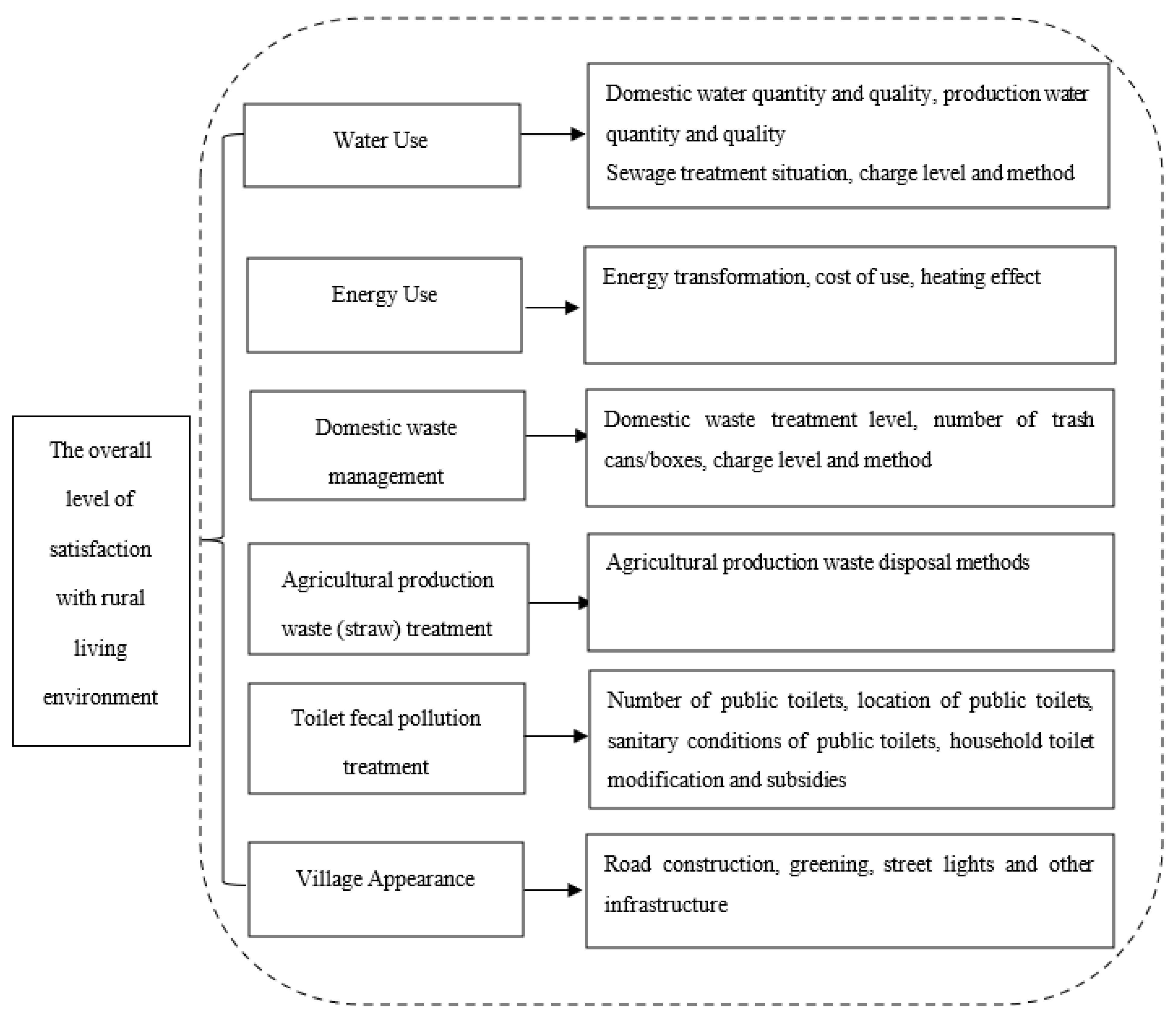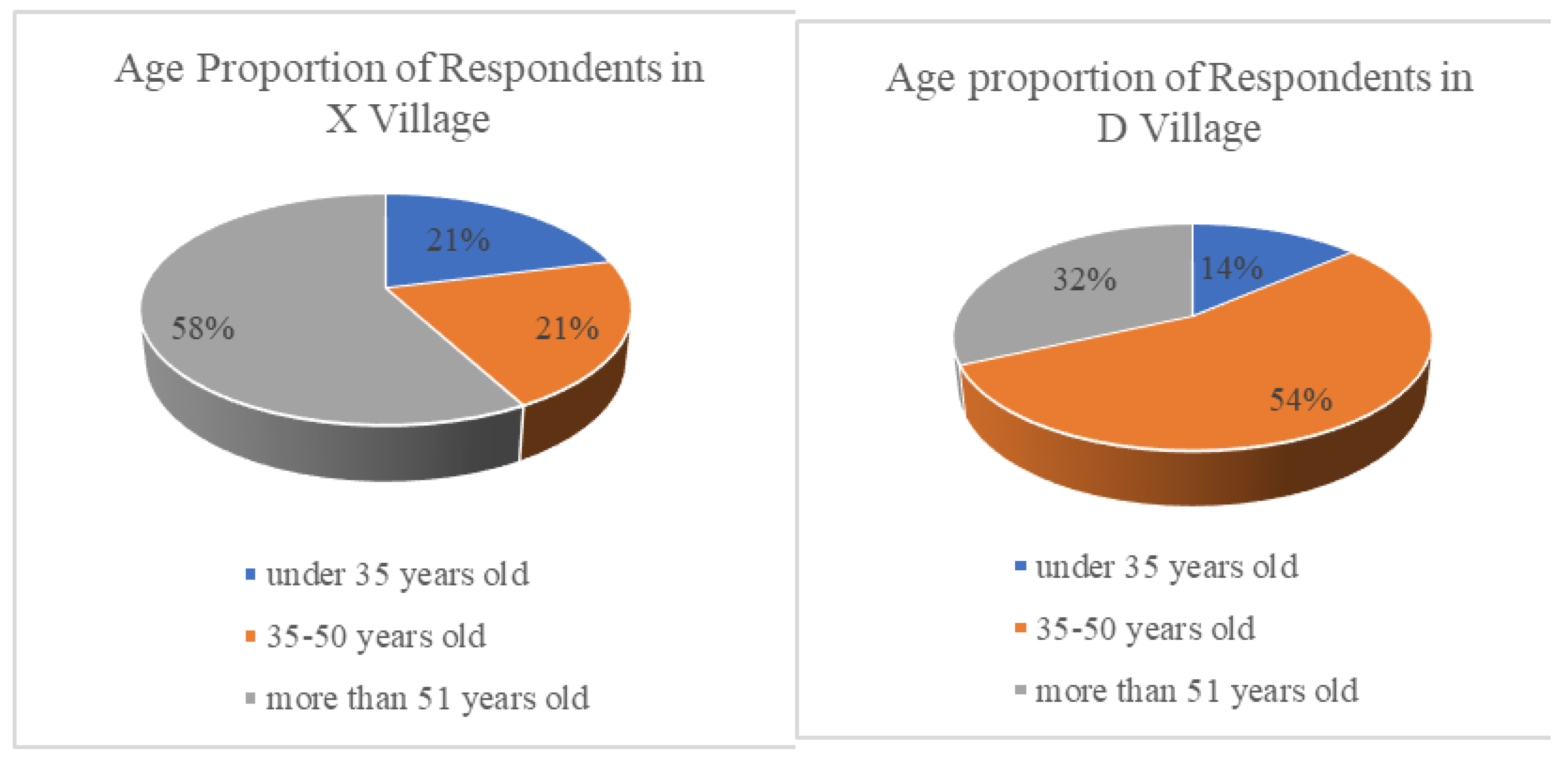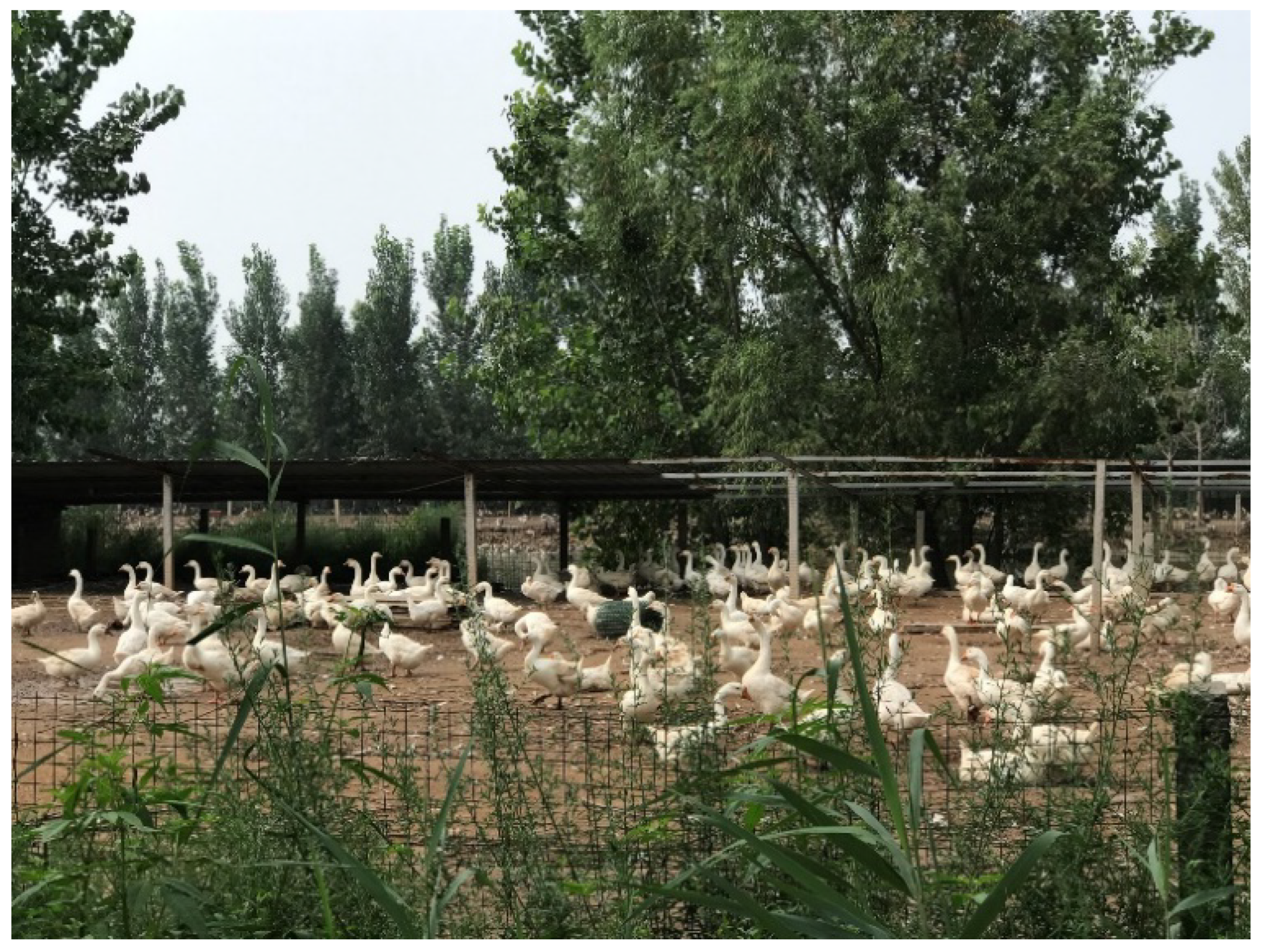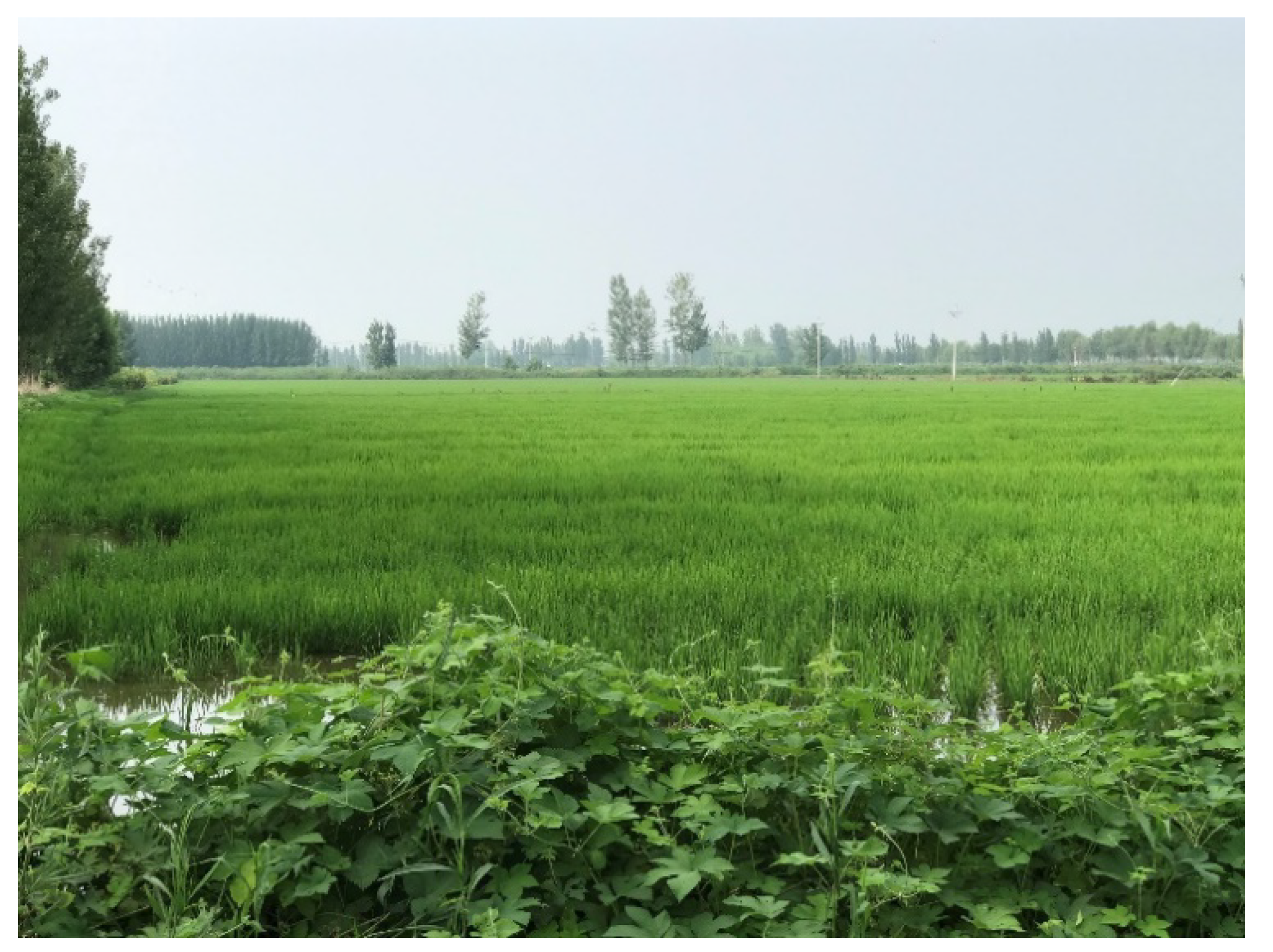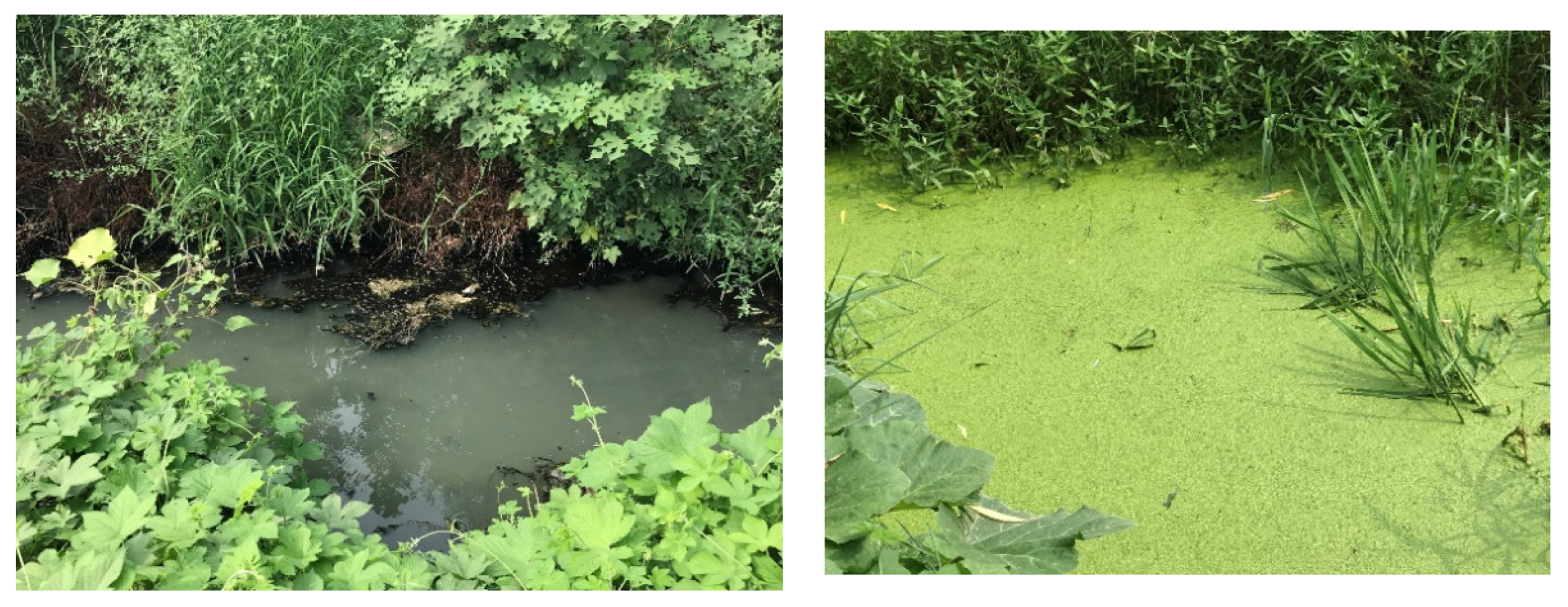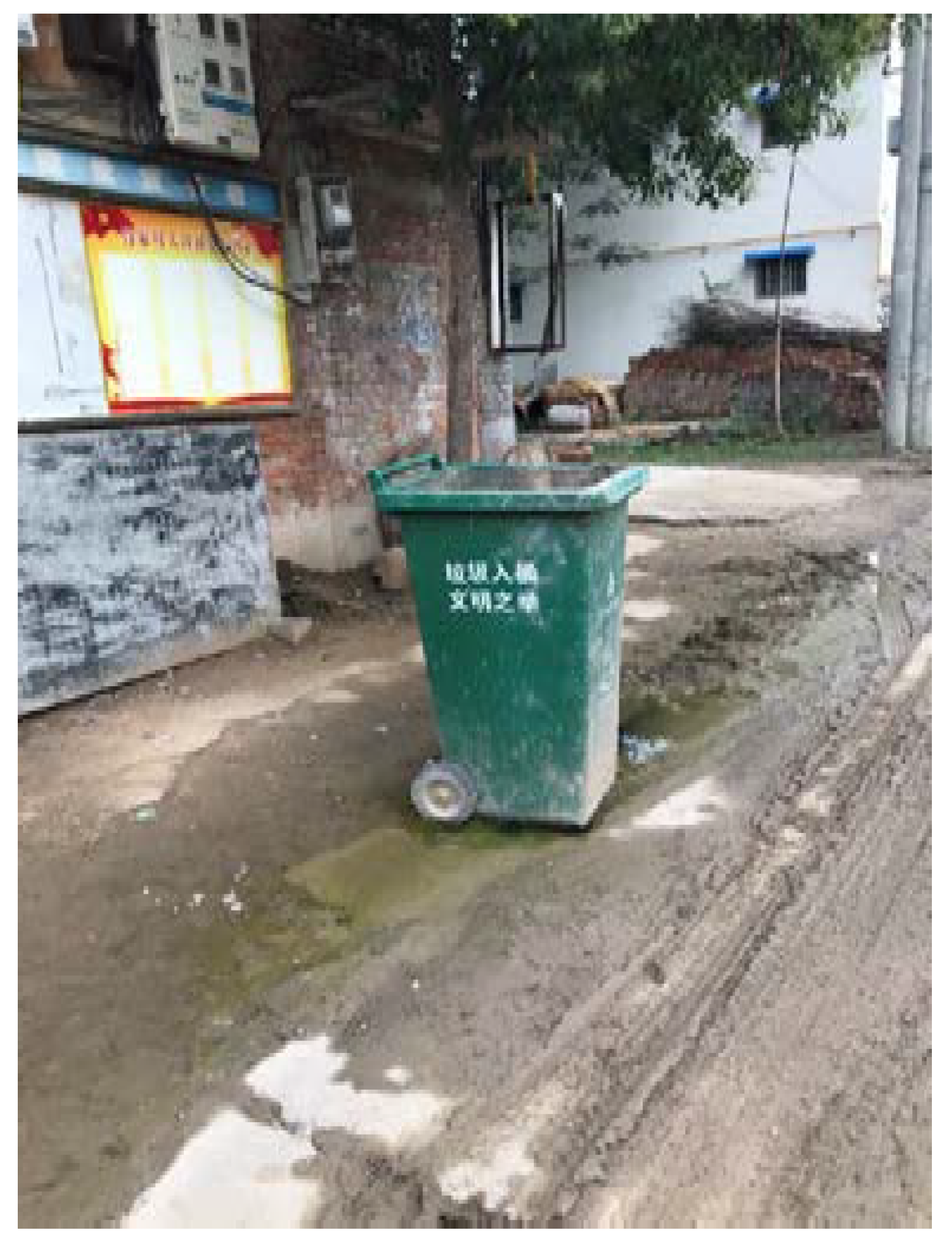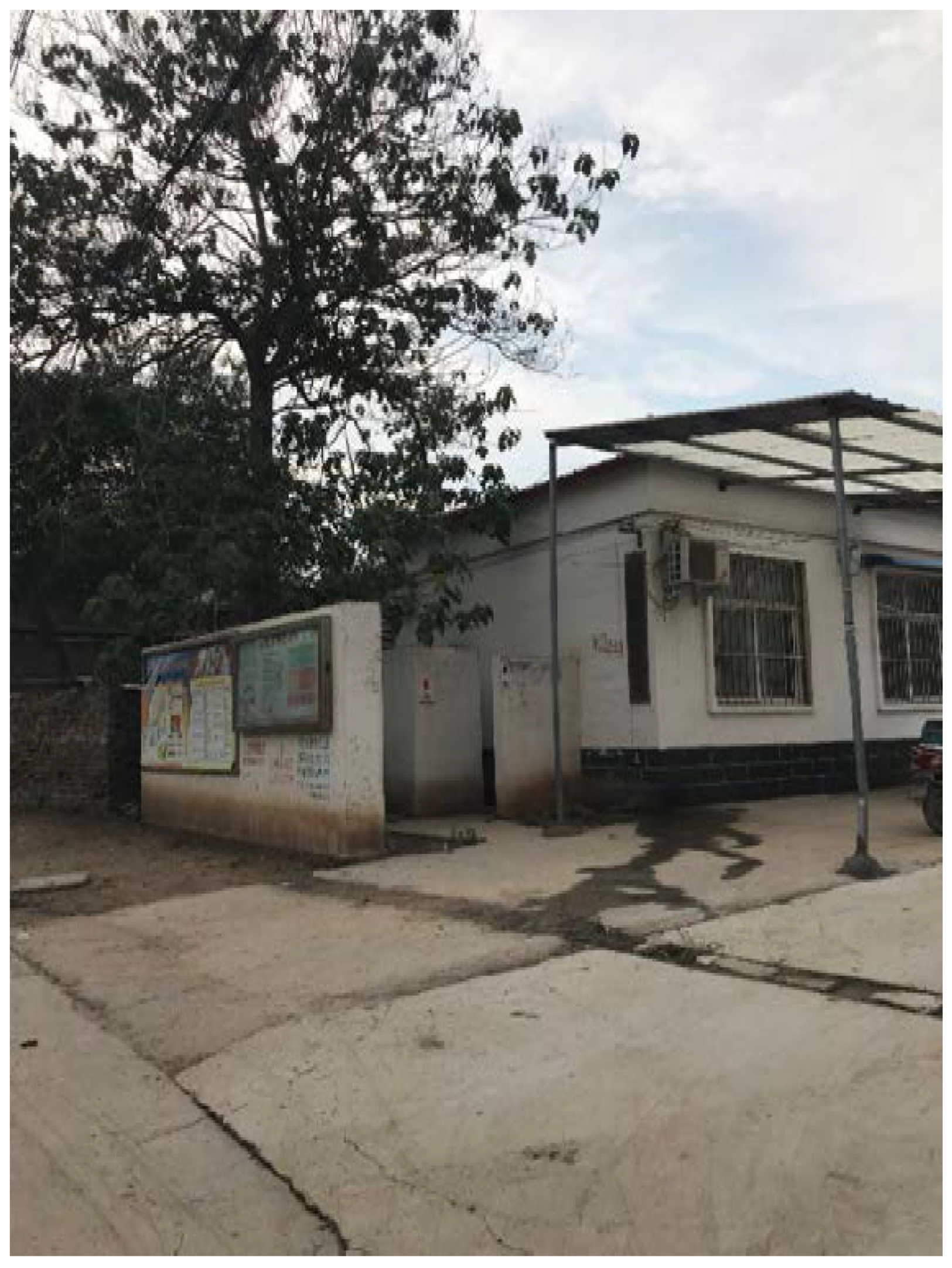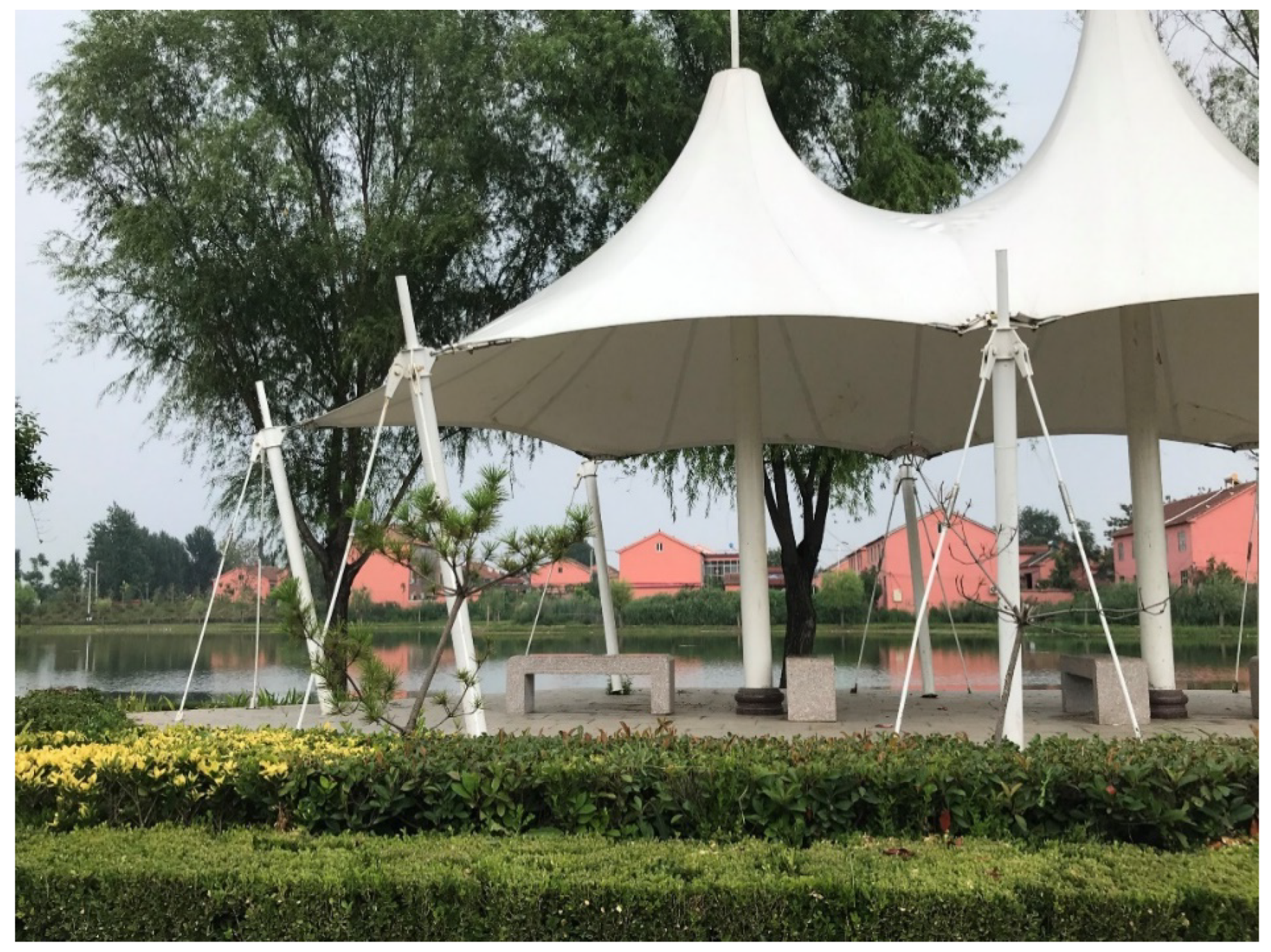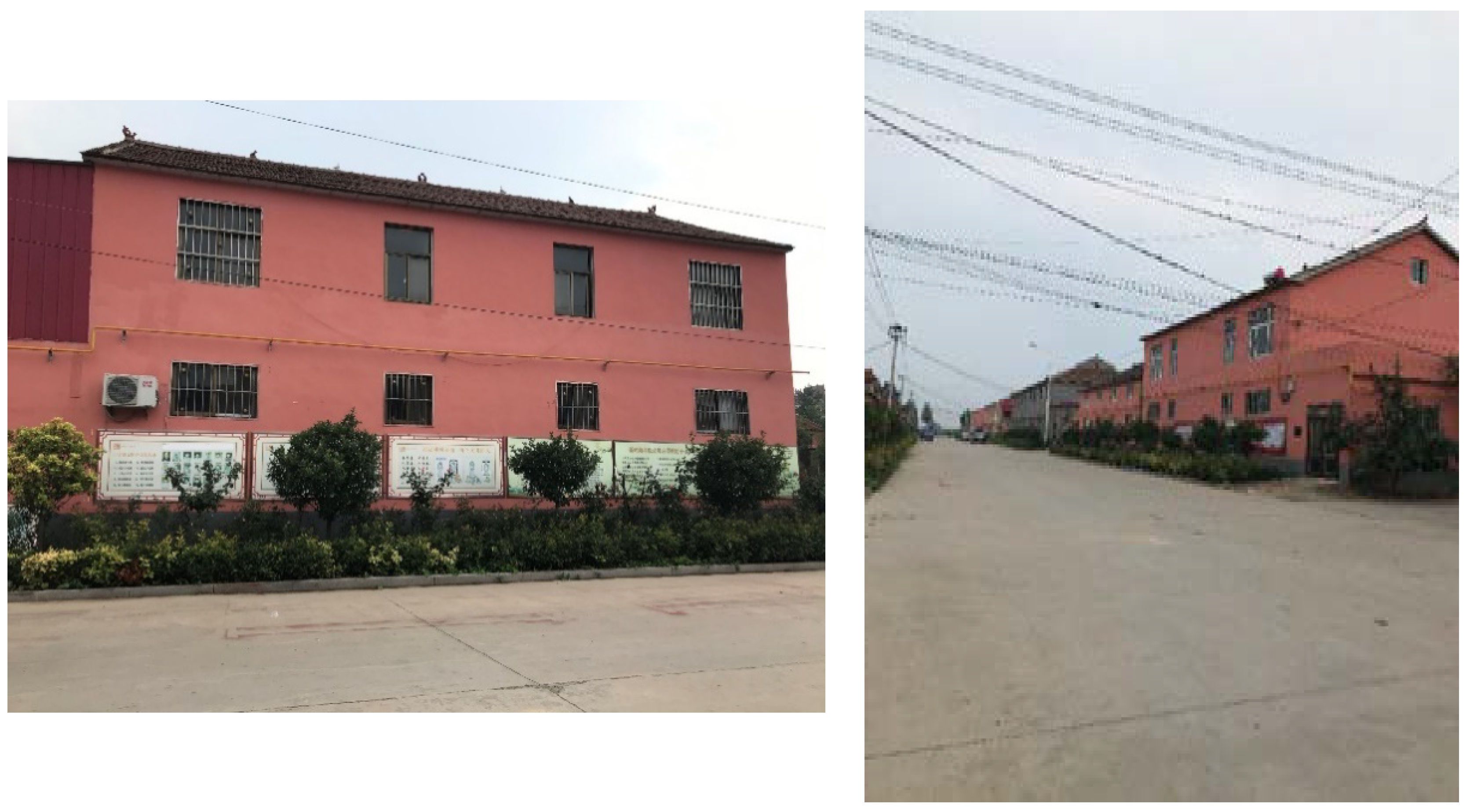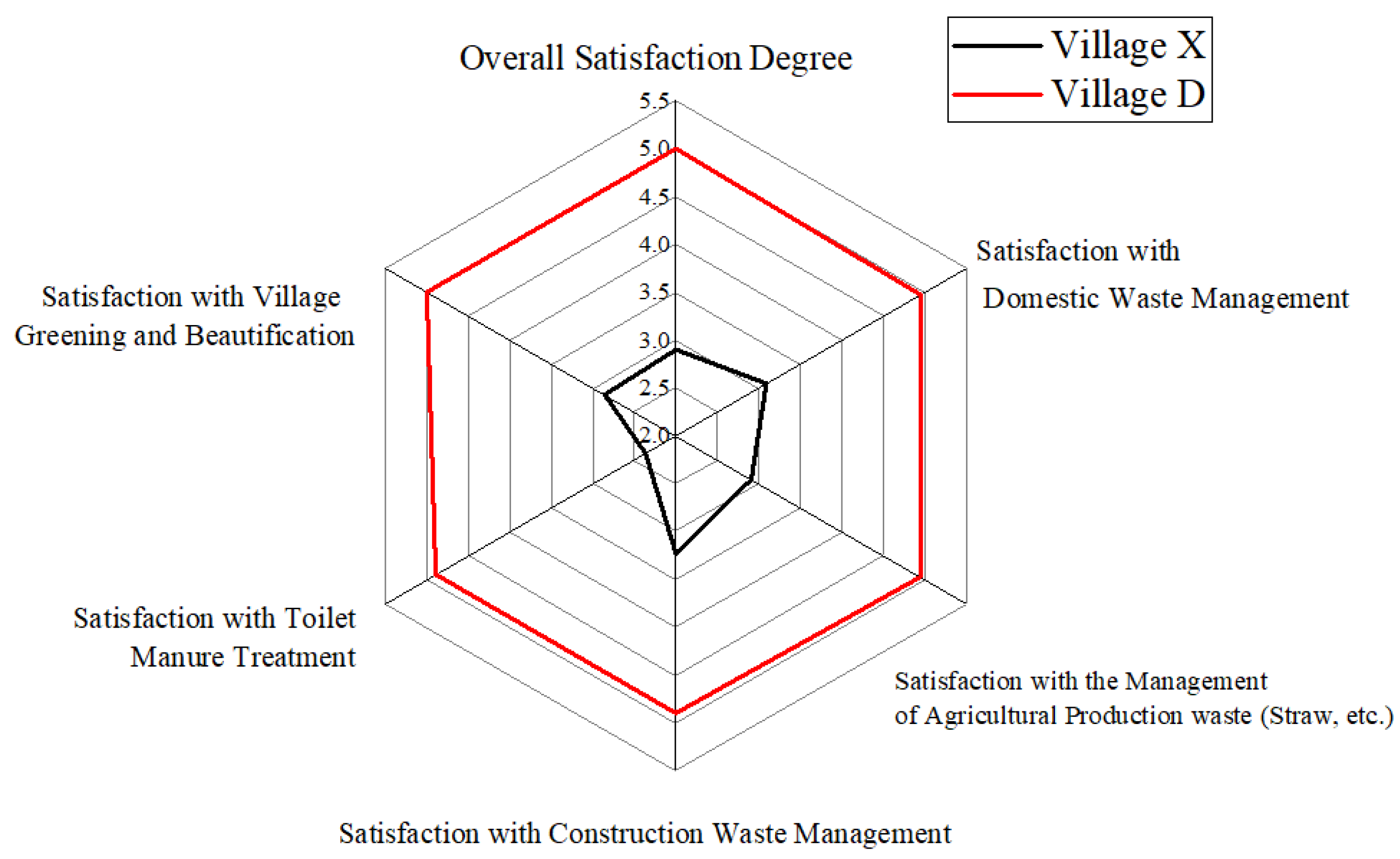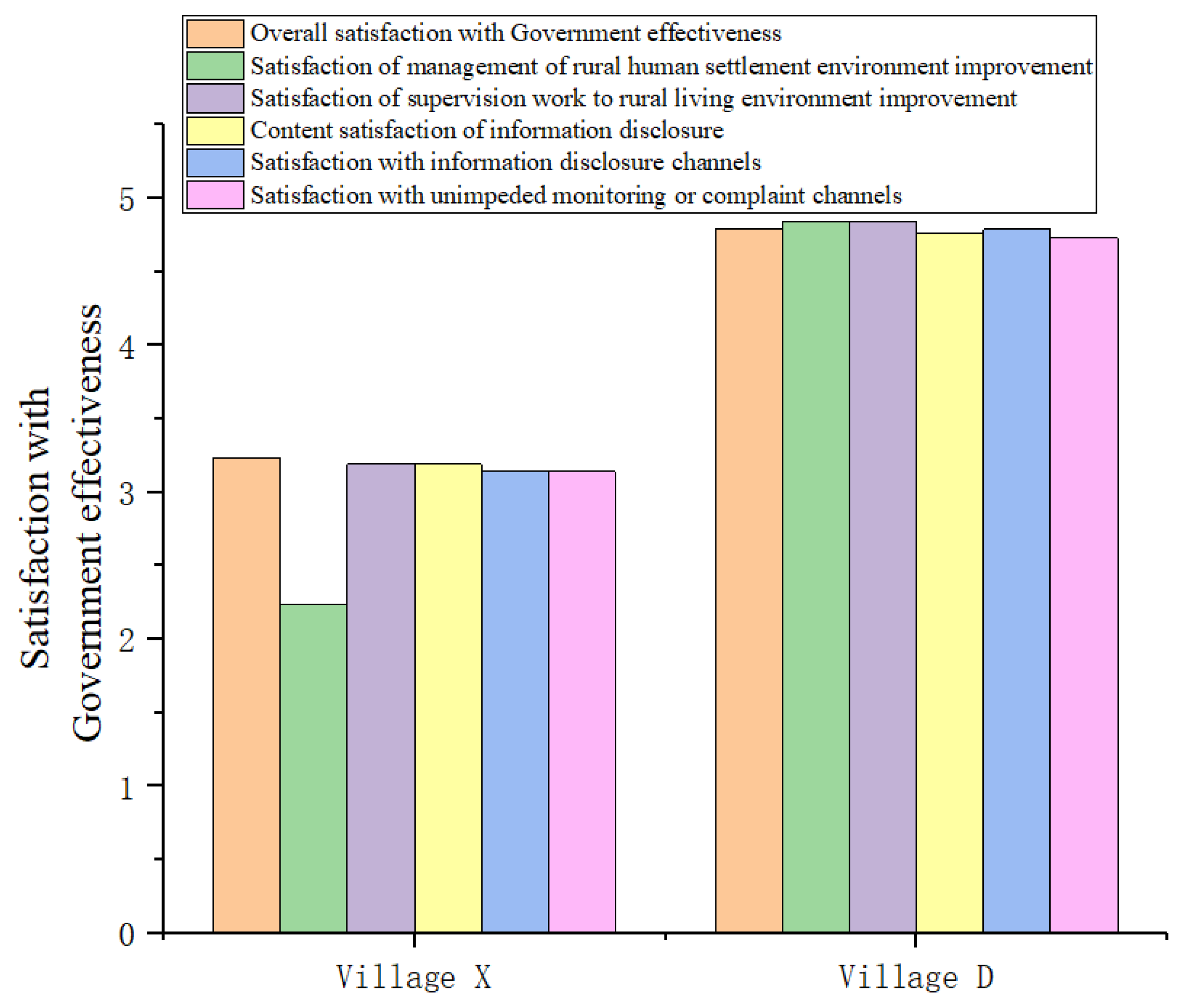1. Introduction
The governance of rural human settlements is an important issue in global economic development. An estimated 880 million people live in poverty in developing countries, and about 50% of the rural population lacks improved sanitation facilities. Poor sanitation around the world contributes to the prevalence of diseases and increased environmental pollution [
1,
2]. According to World Bank estimates, about 68% of the world’s poor live in rural areas worldwide, making a focus on rural areas critical [
3]. Poverty annually costs the world
$260 billion [
4].
From 2013 to 2018, the rural poor population of China decreased from 98.99 million to 16.6 million [
5]. In 2021, China made the historic announcement that they had solved the problem of absolute poverty and that every single person living below the poverty line in rural areas had now been lifted out of poverty [
6]. On 11th May 2021, the results of the seventh national census were released, showing that the population living in urban areas was 901.99 million, accounting for 63.89%; the population living in rural areas was 509.79 million, accounting for 36.11% [
7]. The improvement of the living environment of the rural population, which comprises more than one third of the population, remains an important topic of concern for the government. There is still an imperative for China to make significant improvements to rural living environments across the country.
Improving the living environment in rural areas is an important facet of rural revitalization in China. The rural living environment of China has long lagged behind the living environment in its cities. This undermines China’s aim to build a society in which everyone can prosper. In 2021, the Ministry of Agriculture and Rural Affairs issued the “Five-Year Action Plan for the Improvement of Rural Human Settlements (2021–2025)” [
8]. The document emphasized that during the “14th Five-Year Plan” period, we should continue to promote the improvement of the rural living environment, focusing on improving toilets, sewage, industrial waste disposal, and the long-term mechanism for domestic garbage disposal. Rural human settlements have been explored in a considerable number of areas in China, and remarkable progress has been made. China’s experience in improving rural human settlements could provide a reference for rural governance in other developing countries and regions around the world.
Puyang County is a key county for poverty alleviation and development in Henan Province, which is a major agricultural and grain province in China. The two villages selected in this study are both located in Puyang County, but they have different levels of urbanization and industrialization. X Village is a typical rural area dominated by an agricultural planting industry, while D Village has both an agricultural planting industry and a processing industry. This study is a comparative analysis of two villages in less developed areas of central China focused on farmers’ perceptions of grassroots governance. We used questionnaires, in-depth interviews, and other methods to investigate the feelings and views of farmers, grassroots village cadres, and other stakeholders towards the improvement of the rural living environment. We also evaluated the agency of the farmers themselves, and tried to analyze the factors influencing levels of satisfaction with rural human settlement environments from the perspective of grassroots governance. Finally, we put forward suggestions in line with the actual development scenarios for the improvement of rural human settlements, especially in less developed areas of China. The differences in economic development level and infrastructure between the two villages reflect the differences in rural environmental governance level. Therefore, the results are of great significance for the selection of rural environmental governance decision-making pathways for grassroots initiatives.
2. Rural Environmental Governance
Rural environmental governance combines the challenges of grassroots governance and rural governance. The concept of “governance” is widely used in practice and policy science, and has a variety of meanings [
9,
10,
11]. The government and markets cannot solve the problems of institutional supply, credible commitment, and mutual supervision when faced with collective action. It is therefore necessary to build a “multi-center” governance model with multiple decision-making centers, such as the public, the government, and public entrepreneurs, so that they can consider each other as a system, cooperate with each other in competition, or resort to a central mechanism to resolve conflicts [
12,
13,
14]. However, the government and the market cannot provide adequate solutions to the problems of institutional supply, credible commitment, and mutual supervision when faced with collective action, so we must turn to a third method by which to solve the common pond resource dilemma; specifically, autonomous organization and autonomous governance [
15,
16].
In fact, multiple governance entities or multi-centers are often difficult to coordinate and integrate, resulting in the issue of fragmentation. The functional integration of internal and external institutions in the government system; that is, “holistic governance” [
17]. The “integral governance” overcomes the siloed governance within the government and breaks down the barriers between the government, society, and the market [
18,
19]. They believe that the key to collaboration lies in communication, trust, and institutional arrangements for achieving synergy.
In a comparative study of rural areas in the European Union, socially innovative governance is of great significance for the revitalization of rural areas [
20]. Most scholars focus their explanations on the theory of how stakeholders can participate in grassroots governance problems [
21]. Since the 21st Century, the word ‘governance’ has become increasingly and widely used. This trend indicates that significant changes have taken place in the processes of rural social governance and rural policy implementation [
22]. The state has been redefined as “a coordinator, manager, or facilitator, rather than a provider and master of public goods” [
23]. In rural China, great changes have taken place in grassroots governance since its reform and opening-up. Grassroots governments have played a leading role in providing basic public goods. Meanwhile, the role of public participation in rural grassroots governance has become increasingly prominent. However, there are still big challenges to the administration of grassroots rural governance in China, and further improvement and social innovation are needed in the provision of public goods and services and environmental governance [
24].
Social innovation is related to community participation and empowerment in governance [
25,
26,
27]. The ability of communities to participate in collective processes is an important expression of social innovation [
28,
29,
30,
31], and as the term “stakeholder” has grown in popularity, more and more stakeholders have gradually been included in grassroots governance [
32]. Rural areas often face challenges such as geographic isolation and poor infrastructure, which make government accountability and service delivery particularly challenging and weak. In such circumstances, policymakers may exploit information asymmetries to achieve specific benefits, thereby harming the welfare of rural citizens [
33]. Public participation in rural governance is not only an issue of justice for ordinary people; it can also help the central government in its efforts to induce low-level policymakers [
34,
35]. Providing citizens with information may enable them to better monitor and reward or sanction service providers, thereby incentivizing high-quality public investment.
3. Data and Methods
3.1. Study Areas
China is a vast country with a wide range of geographical features and economic and social levels. Henan Province is located in the middle and lower reaches of the Yellow River in central China, which is located in the transition region from the subtropical zone to the warm temperate zone. It has abundant light and heat resources and has been the cradle of Chinese civilization for thousands of years. Henan is a major agricultural and grain province with a population of more than 100 million. It accounts for 1/16 of the country’s arable land and produces 1/10 of the country’s grain output. Puyang County, with an area of 1420 square kilometers and a population of about 968,700, is a key county for poverty alleviation and development in Henan Province. The two villages selected in this study both are located in Puyang County, Henan Province. X Village is a typical rural area in the traditional sense, mainly centered on the agricultural planting industry, while D Village has both an agricultural planting industry and a processing industry, with relatively high levels of urbanization and industrialization.
3.2. Methodology
The American sociologist Robert C. Merton advocated for the procedure of “formal derivation”, and made every effort to carry out continuous and cumulative investigations and research. This approach seeks to combine investigation with theory, to clarify the problems that should be investigated, and to draw bold hypotheses on this basis [
36]. Fei Xiaotong, a well-known Chinese sociologist, determined in his book “Jiangcun Economics” the need for researchers to limit their investigations to a small social unit for practical reasons [
37]. Yang Maochun also emphasized in his book “A Chinese Village: Taitou, Shandong Province” that it was impossible for one person to cover all parts of China in one study [
38]. A village is a community, characterized by the gathering of peasant households in a compact residential area, which is a group composed of various forms of social activities and is a de facto social unit recognized by people. The results of a study of one small social unit are not necessarily applicable to other units, but such a conclusion can be used as comparative material when conducting investigations elsewhere. Therefore, this study also applies the perspective of rural human settlement environment improvement to two villages. This study discusses the problems of rural human settlement environment improvement in the process of rural revitalization in China by conducting a case analysis of two villages.
After the Ministry of Agriculture and Rural Affairs released the Work Division Plan for Improving Rural Living Environment in 2019, the author conducted a two-week survey in two villages in Puyang County during the holidays. In this study, structured interviews and participatory observation were adopted to obtain first-hand information and data, and the structured interviews were combined with questionnaires. The author was familiar with the general situation of the two villages and designed different interview outlines and questionnaires for village cadres, farmers, and township cadres in the two villages. The interview questions were also tailored for farmers of different ages, genders, and educational backgrounds. The survey interviews adopted the form of “face-to-face” discussions between investigator and farmer, or focused interviews. The chosen subjects of the survey were villagers who had been living in the countryside for a long time, and would be able to provide accounts of the improvement of the local rural living environment over time. The main interviews were conducted in villages, households, and village committees. The interviewees also included government staff and other stakeholders, including county and township cadres who knew about the improvement of the rural living environment, the staff of relevant environmental facilities (mainly sewage treatment facilities), and village cadres who were familiar with the history and present state of social and economic development of the village. Through these methods, the author obtained first-hand information about local perspectives on the improvement of the rural human settlements environment.
The study divided the ecological environmental services provided by the government in rural areas into the following six categories: sewage treatment, household waste treatment, construction waste treatment, toilet treatment, clean energy transformation, and village appearance treatment (
Figure 1). The influencing factors of rural human settlement environment improvement were mainly considered from five aspects: government effectiveness, facility operation, information disclosure, public participation, and social network relationship.
The overall satisfaction with the living environment was scored on the standard Likert scale, and the alternatives were symmetric, so that it was easy to assign values to the alternatives as very satisfied = 5, satisfied = 4, unclear = 3, dissatisfied = 2, and very dissatisfied = 1, so as to calculate the specific satisfaction score and facilitate data analysis and comparison (
Figure 2).
4. Results and Discussion
In this field investigation, a total of 41 villagers from two villages were visited and interviewed, including 22 villagers in X village and 19 villagers in D village. In each village, we analyzed the improvement of the rural living environment through two methods: a questionnaire survey and in-depth interviews. The results showed a significant difference in levels of satisfaction with the improvement of the rural human settlement environment between X Village and D Village. This was because D Village had been greatly supported by government policies in terms of economic development in recent years, including support for the establishment of village-level industrial enterprise parks and government investment in rural environmental governance.
In both villages, the gender ratio of respondents was heavily skewed towards women (
Figure 3). This was because more of the men leave the village for work, while women are more likely to stay behind.
The age range of the interviewees was between 20–67 years old, including six young people (under 35 years old), fifteen middle-aged people (between 36–50 years old), and twenty middle-aged or elderly people (between 51–67 years old). The age distribution of respondents in the two villages (
Figure 4) reflects the fact that most of the rural labor force is over 50 years old, whereas most young and middle-aged people choose to work in other provinces and cities. This is especially true in X Village, where there are no village enterprises to provide employment opportunities.
4.1. The Effect of the Improvement of Human Settlements in X Village
X Village has a total population of 2560 people, 451 households, 26.17% of the labor force, and a per capita annual income of 5100 yuan. It is a provincial-level poverty-stricken village in Henan Province. The total area of cultivated land is 16,466,666.7 square meters. The total area of cultivated land is 16,466,666.7 square meters, 96.8% of which is actual planting area. There are 53 free-range livestock and poultry households in this village, accounting for 22.2% of the farm households (
Figure 5 and
Figure 6). Livestock and poultry are free-range, and the main free-range livestock and poultry species are pigs, geese, etc. The average number of livestock and poultry is 30 per household. The main sources of income for villagers are as follows: 60% from planting, 20% from livestock and poultry farming, and 20% from working outside of farming. According to the information obtained from interviews with the village party secretary and the township, the title of poverty-stricken village was removed in 2017, but poverty alleviation work is still the top priority of rural work. Free-range livestock and poultry breeding has caused many problems, such as agricultural non-point source pollution. Our investigations and interviews revealed that in recent years, livestock and poultry breeding has caused pollution and a stench from small rivers outside the village. According to the villagers, pollution from these activities has been steadily released into the surrounding rivers over recent years. Interviewees reported being able to smell a foul odor all year round. This issue poses a difficulty for the improvement of rural living environment.
In its ‘Five Year Action Plan for the Improvement of the Rural Human Settlement Environment’, the Ministry of Agriculture and Rural Affairs listed water quality and domestic sewage disposal as key areas to target. In X Village, the villagers rely on a groundwater source for all water usage, both domestic and industrial. The survey results suggest that the environmental quality of the water in the Village is poor. According to interviews with villagers, a sample of domestic water was once sent to the health inspection department, and the quality of the water and flora was found to be lacking. The quality of water used in production is also poor due to the discharge of sewage from free-range livestock and poultry. The small river beside the village is polluted by sewage discharge and the leaching of pesticides and fertilizers sprayed on local land, providing a further example of the low water quality (
Figure 7). Direct observations at the site revealed a large quantity of green algae floating on the river’s surface and a pungent smell that matched villagers’ descriptions. The villagers reported that an inspection team had come to investigate sewage discharge and water quality in the village, but the solutions put in place were ineffective because people still let animal sewage flow into the rivers at night. Interviews with the cadres revealed that X Village has become a key target village for water environment improvement in the township. There are currently no sewage treatment facilities in the village, and the township has plans to rectify this. However, due to funding problems, no sewage treatment systems have yet been implemented. Both rural domestic sewage and agricultural production sewage are directly discharged into the river near the village.
These issues with water quality and sewage disposal are exemplified in the account of one villager: “In the past ten years in X Village, because some farmers in the village have raised pigs and some have raised geese, the small river in the village is very smelly. A few years ago, professional pig-raising households and village cadres were relatives. At that time, they made a lot of money on raising pigs, and there were more and more individual pig farmers in the village. Especially in summer, the whole village is filled with the smell of pig manure. Outside people can smell the stench a long way into the village. For him as an example, since his daughter got married to another village, she seldom comes to our village, and every time she went back to my home, she complained that our village was too smelly”. (Interview materials of Interviewee 1; interview time: 2 July 2020)
The interviewee suggested that while responsibilities for improving water quality and environmental management had been officially allocated to grid personnel, no policies had in fact been implemented. Similarly, garbage bins were present in farmers’ households and on the streets, but waste had not been classified in any way (
Figure 8). Special personnel are responsible for cleaning and transportation every day, and collected waste is handled in the central township disposal station.
One of the village cadres in X Village said: “Our village was a backward village, and there was no sewage treatment facility in the village (
Figure 9). The government has long said that it will be built, but no news has been heard until now, it was explained that it might be due to insufficient funds. You can see it when you walk around the village. At present, the laundry water and swill in the village are splashed on the cement street, and dry when the wind blows and the sun dries. Some livestock and poultry farmers’ stinky water was directly discharged into the small river at the east end of the village. We tried to persuade them, but they did not listen to the advice, just hoping the higher-level government departments would take care of it”. (Interview data of village cadre 1; interview time: 4 July 2020)
4.2. The Effect of the Improvement of Human Settlements in D Village
D Village has a total of 917 people and 213 households, with an annual per capita income of 8800 yuan, which is 72.5% higher than that of X Village. The cultivated land area is 653,333.3 square meters, and the actual planting area is 300,000 square meters. There are four livestock and poultry farmers, each raising 1000 pigs, 50 cattle, and 2000 chickens on average. Policy support has enabled the growth of a village-level enterprise industrial park, and the food processing industry contributes nearly 50% of the village’s income. The results of the satisfaction questionnaire and survey interviews showed that levels of satisfaction with the living environment in D Village are generally high. D Village is close to the Model Village of Henan Province and the Rural Party Branch Secretary College of Puyang City of Henan Province, receiving much policy support and government support. It is a typical case of improving the rural living environment in Puyang County (
Figure 10).
Villager 1 of D Village said: “Thanks to the government, our village is much better than other villages in Puyang County. We have village enterprises and grassroots cadres are also playing a leading role. You go to the street to see how clean it is. It has caught up with the life in the city. Every family has a small building, which is a small villa in the city (
Figure 11). We are very satisfied and happy in the village now. There are factories in the village so we can earn wages just like those who work in the city without going to the city. Our wallets are getting bigger and bigger”. (Interview data of Villager 1; interview time: 5 July 2020)
At present, the overall environmental quality of D Village is good, and its geographical location is close to Y Village, which is an advanced typical rural case in Henan Province. Y Village is the location of the Rural Party Branch Secretary College and has excellent transportation and other infrastructure, such as hospitals and factories.
Villager 2 of D Village said: “All the village officials in my village take the lead and demonstrate for the public affairs, so we are very motivated. For example, the renovation of this rural living environment, the wall is red, tile is green, very beautiful! After the street was cleaned, it looked clean wherever I went, and I was in a good mood”. (Interview data of Villager 2; interview time: 5 July 2020)
A reconstruction of the toilets in D Village has been completed and flushing toilets have been fitted. There is one public toilet in the village, near the village committee. In recent years, Q Town sewage treatment plant has been built near the village, with an investment quota of 30 million yuan. There are opportunities for employment in the village’s food processing industries and other work in local enterprises, or remittances from those who work further afield. Overall living conditions are relatively good. This is reflected in the high levels of satisfaction registered in our interview and survey results. The comprehensive provision of public infrastructure at the village level has led to favorable perceptions of the living environment among residents, such as Villager 2 quoted above.
The village cadre of D Village summarizes: “In the past ten years, our village has developed very fast. You can see that our village is close to the Q town government, and there is also a rural market, as early as 20 years ago was a relatively lively place. Our village and Y Village are just across the road. The village party secretary of Y Village is a deputy of Henan Provincial People’s Congress, and Y Village is now the Rural Party Branch Secretary College. It was a national priority, and our village was also covered with it. You can see that our village has developed so fast. There are village-run enterprises in the village. There are many girls and boys from nearby villages who come to work here. College students from our village also come back to work. The development is getting better and better.” (Interview data of village cadre 2; interview time: 6 July 2020)
4.3. Comparison of the Improvement Effect of Rural Human Settlement Environment in Two Villages
Our interviews and survey data revealed that the degree of satisfaction with the rural living environment differed between X and D Villages. The overall satisfaction level in X Village was low. Among the villagers surveyed, 27.3% expressed that they were very dissatisfied with the effects of improvements to the living environment, and half of the residents expressed doubts about its success. By contrast, in D Village, the overall level of satisfaction with the rural living environment was extremely high, at 100%. The average Likert score for overall satisfaction levels in X Village was 2.9, compared to 5.0 in D Village. The two villages are geographically proximate (only 3 km apart), but the gap in their levels of economic development and per capita income is significant. This economic difference is one of the factors directly contributing to the vast difference in degrees of satisfaction with rural living environments.
The initiative to improve the rural living environment mainly includes improvements to: domestic waste management, agricultural production waste management, construction waste management, and toilet manure management, as well as village appearance, greening, and beautification. According to the survey results, the level of satisfaction of villagers in X Village was 3.09 for domestic waste treatment, 2.91 for agricultural production waste (straw), 3.23 for construction waste treatment, 2.36 for toilet manure treatment, and 2.86 for village appearance, greening, and beautification. The satisfaction levels for each of these categories in D Village were extremely high in comparison. In those surveyed in D Village, the level of satisfaction was 4.95 for the treatment of domestic waste, 4.95 for the treatment of agricultural production waste, and 4.89 for construction waste management (
Figure 12). The satisfaction level for toilet manure treatment was 4.89, and village appearance, greening, and beautification scored 5.00. The differing levels of satisfaction across these categories are displayed visually in
Figure 13.
4.4. Analysis on the Effect of Rural Living Environment Improvement and its Influencing Factors
Many factors affect the improvement of rural living environments. The reasons for poorer environmental awareness among rural residents may include their beliefs, incomes, and education levels in comparison to those of urban dwellers [
39,
40]. The authors argue that changes to the value structures of rural residents, increasing government support for improvements to the living environment, and enhanced education levels in villages can all combine to effectively promote greater awareness of environmental issues and actions. The management of rural living environments should be strengthened, and rural villagers need to be the key agents in the improvement of their living environments [
41,
42,
43]. Meanwhile, policies and regulations should be adopted which encourage villagers’ enthusiasm and initiative to protect their environments [
44,
45].
The two villages in this study are geographically adjacent and have similar resource endowments (
Table 1), but there is a huge difference in their levels of economic development, satisfaction, and rural human settlement environment improvement. Why is there such a stark difference? To answer this question, a survey was conducted to gain farmers’ perspectives on the effectiveness and governance of remediation work deployment and management, and supervision as provided by governments in the improvement of the rural living environment. In-depth interviews were also conducted with village organizations, village cadres, and township government members. The investigation found that grassroots governments play an important leading role in rural revitalization and rural living environment improvement.
The governance of rural living environments is predominantly steered by the government. Correspondingly, the deployment ability and management level of the government are the key factors affecting farmers’ overall satisfaction scores. Satisfaction is a subjective evaluation index of service quality and is significantly impacted by whether or not farmers feel they have benefited from the improvement of the rural living environment. The literature suggests that social trust is a “lubricant for society,” and is integral to effective democratic governance at all levels. In democracies, higher levels of social trust are often accompanied by more active governments and more cooperative communities, which in turn lead to better performance in grassroots governance. The survey results show that there is a significant difference in how satisfied residents were with the government’s effectiveness in improving the living environment in X Village and D Village. Residents in X Village returned an average score of 3.23 for the efficacy of the government’s residential environment improvement work, compared to 4.79 in D Village. The same pattern was reflected in the various specific areas covered by the survey. In X Village, the satisfaction score was 2.23 for the government’s rural living environment improvement and management work, 3.14 for the content of information disclosures, and 3.14 for the channels of information dissemination. The corresponding scores for D Village were 4.84, 4.76, and 4.79 (
Figure 13). There is a clear correlation between the level of satisfaction with the overall improvement of the living environment in each village and the level of satisfaction with the government’s role in bringing it about. It can be said that government effectiveness has played an important role in rural environmental remediation.
Through our survey, we found that some farmers lacked awareness that they could actively participate and have their interests represented, but they believed that the government’s initiative to provide remediation services had brought improvements. However, in X Village, the results uncovered a lack of mechanisms for participation and expressing opinions, and a lack of timely and sufficient responses from the government; as a result, the main demands brought by farmers had been ignored and many did not believe that participation was effective or worthwhile.
The grassroots government has an important role in promoting and implementing policy in rural villages. However, solely focusing on the local state can overemphasize the agency of grassroots governments, and downplay the importance of external influences and constraints. In D Village, the grassroots government departments led the villagers in a complete clean-up of household waste on the streets; both in front of and behind houses. This initiative dramatically improved the appearance of the village and acted as a “leading goose” catalyzing further changes in the locality. The grassroots organization department of D Village has since actively explored the establishment of a more long-term mechanism for the improvement of the living environment. Such a mechanism would enable a transition from government-led implementation to widespread public participation, from the kind of ‘assault-style’ rectification described above to normalized patterns of cleaning and maintenance, and from extensive to refined management.
4.5. The Role of Public Participation on Rural Living Environment Improvement
Public participation is a redistribution of power and needs to be included in institutions and structures of governance [
46,
47]. Scholars have identified a multitude of benefits for both governments and citizens associated with such civic engagement. For example, public participation can serve various political purposes, helping to improve policy decisions, realize democratic values, and promote policy implementation [
48,
49]. Citizen participation can also improve the effectiveness of service delivery [
50,
51,
52]. Participatory governance can help avoid social choice dilemmas as individual preferences become more socialized through the processes of repeated dialog and participation [
53,
54,
55]. The most direct and reliable way to make participation effective is to provide wider opportunities for members of the public to get involved [
56]. Indeed, the efforts to improve the living environment in D Village have been greatly impacted by the expansion of participatory methods, such as villagers’ meetings, which have led to increased enthusiasm among farmers to participate in grassroots governance.
This is evident in the words of one villager: “Thanks to our village cadres, who led us all to a happy and healthy road together. When we encounter information about toilet renovation, garbage collection, etc., that everyone cares about in our village, village cadres will solicit opinions from everyone through loudspeaker broadcasts, door-to-door visits, and village meetings. The village is our own home. Only when the village is developed can we farmers become rich together. Therefore, everyone is very active and motivated in the construction of their own home”. (Interview data of interviewed Villager X; interview time: 8 July 2020)
The improvement of the rural living environment is inseparable from the participation of farmers. Rural residents differ in their attitudes towards environmental governance and in their actions, and this difference leads to political behaviors that reflect the dynamics of their environmental actions. The level of resident engagement in participatory governance of the rural living environment ranges from inaction or irresponsible behavior to active environmental care. These different forms of engagement are important manifestations of public participation in grassroots governance.
5. Conclusions
The improvement of the rural living environment is a key task in the implementation of China’s rural revitalization strategy. It underpins the fundamental well-being of farmers, the health of farmers, and the construction of a beautiful China. Based on the survey of farmers in two villages in the underdeveloped areas of central China, this study explores the feelings of farmers in different villages towards the improvement of the rural living environment, and tries to analyze the factors affecting the satisfaction of rural living environment from the perspective of grassroots governance. The survey results from X Village and D Village in the central part of Henan Province pointed to a huge difference in the overall satisfaction of the two villages regarding the improvement of the rural living environment.
In order to further analyze the influencing factors behind these differing levels of satisfaction, the study conducted in-depth interviews with authority figures, such as members of grass-roots organizations, village cadres, and township governments, to probe the nature and efficiency of the local government and its structures of governance. The grassroots government is the key driver of rural environmental governance, and the study found that its ability to deploy policy and manage services are the most influential factors determining farmers’ evaluation of the overall level of rural living environment improvement. The rural grass-roots government plays an important leading role in the revitalization of the countryside and the improvement of the rural living environment.
Rural living environment remediation work has many aspects, involves many departments, is difficult to coordinate, and has large regional differences. Village environmental remediation should be closely integrated with the layout of rural industries and overall planning of environmental remediation goals and methods for different functional areas. Rural governance should respect the wishes of villagers, stimulate endogenous motivation, and protect villagers’ rights to know, to participate, to express, and to supervise. It should strengthen the responsibility of local governments, encourage the active participation of social forces, and facilitate multi-party co-construction and co-management by the government, market players, village collectives, and villagers.
The construction of treatment facilities and the operation and maintenance of infrastructures for the improvement of the rural human settlement environment require a large amount of capital investment. The level of economic development in different regions is different, and it is not possible to blindly pursue strategies of “walking in unison” and “one size fits all”. The differences in natural endowments and economic and social development levels in different regions determine that the established goals and completion time requirements of human settlement environment renovation tasks should also be different. It is suggested that governments at all levels adopt differentiated support policies, and determine differentiated assessment methods and assessment indicators for rural human settlement environment improvement according to different regional characteristics and different levels of economic development.
